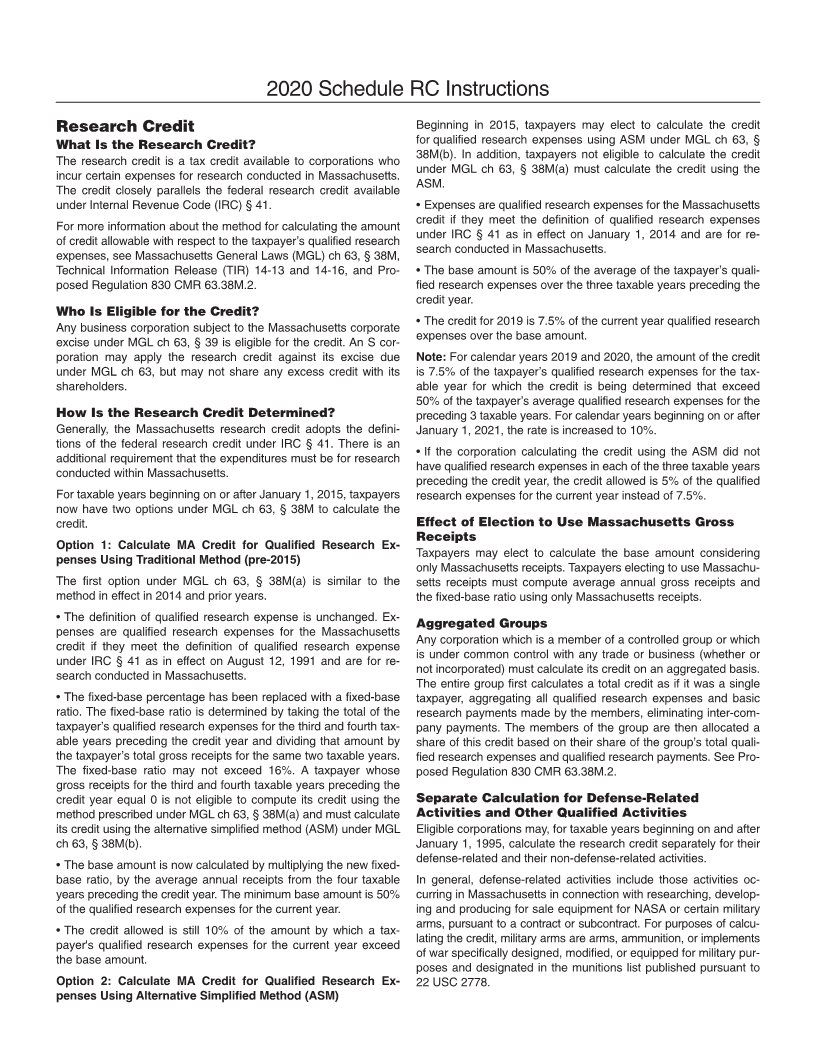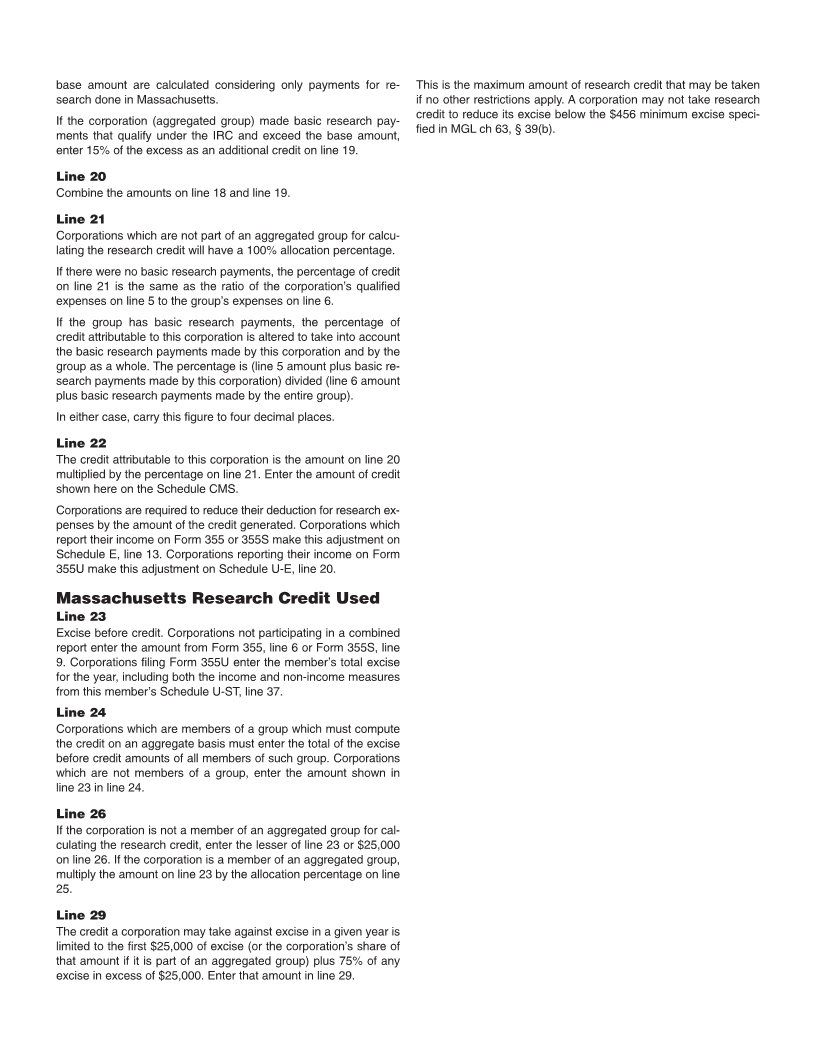
Enlarge image
2020 Schedule RC Instructions
Research Credit Beginning in 2015, taxpayers may elect to calculate the credit
What Is the Research Credit? for qualified research expenses using ASM under MGL ch 63, §
38M(b). In addition, taxpayers not eligible to calculate the credit
The research credit is a tax credit available to corporations who
under MGL ch 63, § 38M(a) must calculate the credit using the
incur certain expenses for research conducted in Massachusetts.
ASM.
The credit closely parallels the federal research credit available
under Internal Revenue Code (IRC) § 41. • Expenses are qualified research expenses for the Massachusetts
credit if they meet the definition of qualified research expenses
For more information about the method for calculating the amount
under IRC § 41 as in effect on January 1, 2014 and are for re-
of credit allowable with respect to the taxpayer’s qualified research
search conducted in Massachusetts.
expenses, see Massachusetts General Laws (MGL) ch 63, § 38M,
Technical Information Release (TIR) 14-13 and 14-16, and Pro- • The base amount is 50% of the average of the taxpayer’s quali-
posed Regulation 830 CMR 63.38M.2. fied research expenses over the three taxable years preceding the
credit year.
Who Is Eligible for the Credit?
• The credit for 2019 is 7.5% of the current year qualified research
Any business corporation subject to the Massachusetts corporate
expenses over the base amount.
excise under MGL ch 63, § 39 is eligible for the credit. An S cor -
poration may apply the research credit against its excise due Note: For calendar years 2019 and 2020, the amount of the credit
under MGL ch 63, but may not share any excess credit with its is 7.5% of the taxpayer’s qualified research expenses for the tax-
shareholders. able year for which the credit is being determined that exceed
50% of the taxpayer’s average qualified research expenses for the
How Is the Research Credit Determined? preceding 3 taxable years. For calendar years beginning on or after
Generally, the Massachusetts research credit adopts the defini- January 1, 2021, the rate is increased to 10%.
tions of the federal research credit under IRC § 41. There is an
• If the corporation calculating the credit using the ASM did not
additional requirement that the expenditures must be for research
have qualified research expenses in each of the three taxable years
conducted within Massachusetts.
preceding the credit year, the credit allowed is 5% of the qualified
For taxable years beginning on or after January 1, 2015, taxpayers research expenses for the current year instead of 7.5%.
now have two options under MGL ch 63, § 38M to calculate the
credit. Effect of Election to Use Massachusetts Gross
Receipts
Option 1: Calculate MA Credit for Qualified Research Ex- Taxpayers may elect to calculate the base amount considering
penses Using Traditional Method (pre-2015) only Massachusetts receipts. Taxpayers electing to use Massachu-
The first option under MGL ch 63, § 38M(a) is similar to the setts receipts must compute average annual gross receipts and
method in effect in 2014 and prior years. the fixed-base ratio using only Massachusetts receipts.
• The definition of qualified research expense is unchanged. Ex- Aggregated Groups
penses are qualified research expenses for the Massachusetts
Any corporation which is a member of a controlled group or which
credit if they meet the definition of qualified research expense
is under common control with any trade or business (whether or
under IRC § 41 as in effect on August 12, 1991 and are for re-
not incorporated) must calculate its credit on an aggregated basis.
search conducted in Massachusetts.
The entire group first calculates a total credit as if it was a single
• The fixed-base percentage has been replaced with a fixed-base taxpayer, aggregating all qualified research expenses and basic
ratio. The fixed-base ratio is determined by taking the total of the research payments made by the members, eliminating inter-com-
taxpayer’s qualified research expenses for the third and fourth tax- pany payments. The members of the group are then allocated a
able years preceding the credit year and dividing that amount by share of this credit based on their share of the group’s total quali-
the taxpayer’s total gross receipts for the same two taxable years. fied research expenses and qualified research payments. See Pro-
The fixed-base ratio may not exceed 16%. A taxpayer whose posed Regulation 830 CMR 63.38M.2.
gross receipts for the third and fourth taxable years preceding the
credit year equal 0 is not eligible to compute its credit using the Separate Calculation for Defense-Related
method prescribed under MGL ch 63, § 38M(a) and must calculate Activities and Other Qualified Activities
its credit using the alternative simplified method (ASM) under MGL Eligible corporations may, for taxable years beginning on and after
ch 63, § 38M(b). January 1, 1995, calculate the research credit separately for their
defense-related and their non-defense-related activities.
• The base amount is now calculated by multiplying the new fixed-
base ratio, by the average annual receipts from the four taxable In general, defense-related activities include those activities oc-
years preceding the credit year. The minimum base amount is 50% curring in Massachusetts in connection with researching, develop-
of the qualified research expenses for the current year. ing and producing for sale equipment for NASA or certain military
arms, pursuant to a contract or subcontract. For purposes of calcu-
• The credit allowed is still 10% of the amount by which a tax-
lating the credit, military arms are arms, ammunition, or implements
payer's qualified research expenses for the current year exceed
of war specifically designed, modified, or equipped for military pur-
the base amount.
poses and designated in the munitions list published pursuant to
Option 2: Calculate MA Credit for Qualified Research Ex- 22 USC 2778.
penses Using Alternative Simplified Method (ASM)


